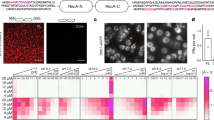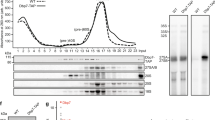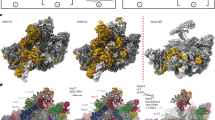Abstract
The DEAD-box protein DBP5 is essential for mRNA export in both yeast and humans. It binds RNA and is concentrated and locally activated at the cytoplasmic side of the nuclear pore complex. We have determined the crystal structures of human DBP5 bound to RNA and AMPPNP, and bound to the cytoplasmic nucleoporin NUP214. The structures reveal that binding of DBP5 to nucleic acid and to NUP214 is mutually exclusive. Using in vitro assays, we demonstrate that NUP214 decreases both the RNA binding and ATPase activities of DBP5. The interactions are mediated by conserved residues, implying a conserved recognition mechanism. These results suggest a framework for the consecutive steps leading to the release of mRNA at the final stages of nuclear export. More generally, they provide a paradigm for how binding of regulators can specifically inhibit DEAD-box proteins.
This is a preview of subscription content, access via your institution
Access options
Subscribe to this journal
Receive 12 print issues and online access
$189.00 per year
only $15.75 per issue
Buy this article
- Purchase on Springer Link
- Instant access to full article PDF
Prices may be subject to local taxes which are calculated during checkout




Similar content being viewed by others
References
Terry, L.J., Shows, E.B. & Wente, S.R. Crossing the nuclear envelope: hierarchical regulation of nucleocytoplasmic transport. Science 318, 1412–1416 (2007).
Lim, R.Y., Ullman, K.S. & Fahrenkrog, B. Biology and biophysics of the nuclear pore complex and its components. Int. Rev. Cell Mol. Biol. 267, 299–342 (2008).
Schwartz, T.U. Modularity within the architecture of the nuclear pore complex. Curr. Opin. Struct. Biol. 15, 221–226 (2005).
Frey, S. & Gorlich, D. A saturated FG-repeat hydrogel can reproduce the permeability properties of nuclear pore complexes. Cell 130, 512–523 (2007).
Alber, F. et al. The molecular architecture of the nuclear pore complex. Nature 450, 695–701 (2007).
Kohler, A. & Hurt, E. Exporting RNA from the nucleus to the cytoplasm. Nat. Rev. Mol. Cell Biol. 8, 761–773 (2007).
Cole, C.N. & Scarcelli, J.J. Transport of messenger RNA from the nucleus to the cytoplasm. Curr. Opin. Cell Biol. 18, 299–306 (2006).
Cook, A., Bono, F., Jinek, M. & Conti, E. Structural biology of nucleocytoplasmic transport. Annu. Rev. Biochem. 76, 647–671 (2007).
Grant, R.P., Neuhaus, D. & Stewart, M. Structural basis for the interaction between the Tap/NXF1 UBA domain and FG nucleoporins at 1 resolution. J. Mol. Biol. 326, 849–858 (2003).
Fribourg, S., Braun, I.C., Izaurralde, E. & Conti, E. Structural basis for the recognition of a nucleoporin FG repeat by the NTF2-like domain of the TAP/p15 mRNA nuclear export factor. Mol. Cell 8, 645–656 (2001).
Iglesias, N. & Stutz, F. Regulation of mRNP dynamics along the export pathway. FEBS Lett. 582, 1987–1996 (2008).
Stewart, M. Ratcheting mRNA out of the nucleus. Mol. Cell 25, 327–330 (2007).
Snay-Hodge, C.A., Colot, H.V., Goldstein, A.L. & Cole, C.N. Dbp5p/Rat8p is a yeast nuclear pore-associated DEAD-box protein essential for RNA export. EMBO J. 17, 2663–2676 (1998).
Tseng, S.S. et al. Dbp5p, a cytosolic RNA helicase, is required for poly(A)+ RNA export. EMBO J. 17, 2651–2662 (1998).
Schmitt, C. et al. Dbp5, a DEAD-box protein required for mRNA export, is recruited to the cytoplasmic fibrils of nuclear pore complex via a conserved interaction with CAN/Nup159p. EMBO J. 18, 4332–4347 (1999).
Kraemer, D., Wozniak, R.W., Blobel, G. & Radu, A. The human CAN protein, a putative oncogene product associated with myeloid leukemogenesis, is a nuclear pore complex protein that faces the cytoplasm. Proc. Natl. Acad. Sci. USA 91, 1519–1523 (1994).
Del Priore, V. et al. A structure/function analysis of Rat7p/Nup159p, an essential nucleoporin of Saccharomyces cerevisiae. J. Cell Sci. 110, 2987–2999 (1997).
Cheng, Z., Coller, J., Parker, R. & Song, H. Crystal structure and functional analysis of DEAD-box protein Dhh1p. RNA 11, 1258–1270 (2005).
Shi, H., Cordin, O., Minder, C.M., Linder, P. & Xu, R.M. Crystal structure of the human ATP-dependent splicing and export factor UAP56. Proc. Natl. Acad. Sci. USA 101, 17628–17633 (2004).
Sengoku, T., Nureki, O., Nakamura, A., Kobayashi, S. & Yokoyama, S. Structural basis for RNA unwinding by the DEAD-box protein Drosophila Vasa. Cell 125, 287–300 (2006).
Bono, F., Ebert, J., Lorentzen, E. & Conti, E. The crystal structure of the exon junction complex reveals how it maintains a stable grip on mRNA. Cell 126, 713–725 (2006).
Andersen, C.B. et al. Structure of the exon junction core complex with a trapped DEAD-box ATPase bound to RNA. Science 313, 1968–1972 (2006).
Jankowsky, E. & Fairman, M.E. RNA helicases-one fold for many functions. Curr. Opin. Struct. Biol. 17, 316–324 (2007).
Cordin, O., Banroques, J., Tanner, N.K. & Linder, P. The DEAD-box protein family of RNA helicases. Gene 367, 17–37 (2006).
Weirich, C.S. et al. Activation of the DExD/H-box protein Dbp5 by the nuclear-pore protein Gle1 and its coactivator InsP6 is required for mRNA export. Nat. Cell Biol. 8, 668–676 (2006).
Alcazar-Roman, A.R., Tran, E.J., Guo, S. & Wente, S.R. Inositol hexakisphosphate and Gle1 activate the DEAD-box protein Dbp5 for nuclear mRNA export. Nat. Cell Biol. 8, 711–716 (2006).
Lund, M.K. & Guthrie, C. The DEAD-box protein Dbp5p is required to dissociate Mex67p from exported mRNPs at the nuclear rim. Mol. Cell 20, 645–651 (2005).
Tran, E.J., Zhou, Y., Corbett, A.H. & Wente, S.R. The DEAD-box protein Dbp5 controls mRNA export by triggering specific RNA:protein remodeling events. Mol. Cell 28, 850–859 (2007).
Zhao, J., Jin, S.B., Bjorkroth, B., Wieslander, L. & Daneholt, B. The mRNA export factor Dbp5 is associated with Balbiani ring mRNP from gene to cytoplasm. EMBO J. 21, 1177–1187 (2002).
Estruch, F. & Cole, C.N. An early function during transcription for the yeast mRNA export factor Dbp5p/Rat8p suggested by its genetic and physical interactions with transcription factor IIH components. Mol. Biol. Cell 14, 1664–1676 (2003).
Gross, T. et al. The DEAD-box RNA helicase Dbp5 functions in translation termination. Science 315, 646–649 (2007).
Scarcelli, J.J. et al. Synthetic genetic array analysis in Saccharomyces cerevisiae provides evidence for an interaction between RAT8/DBP5 and genes encoding P-body components. Genetics 179, 1945–1955 (2008).
Napetschnig, J., Blobel, G. & Hoelz, A. Crystal structure of the N-terminal domain of the human protooncogene Nup214/CAN. Proc. Natl. Acad. Sci. USA 104, 1783–1788 (2007).
Weirich, C.S., Erzberger, J.P., Berger, J.M. & Weis, K. The N-terminal domain of Nup159 forms a β-propeller that functions in mRNA export by tethering the helicase Dbp5 to the nuclear pore. Mol. Cell 16, 749–760 (2004).
Reichmann, D., Phillip, Y., Carmi, A. & Schreiber, G. On the contribution of water-mediated interactions to protein-complex stability. Biochemistry 47, 1051–1060 (2008).
Miller, A.L. et al. Cytoplasmic inositol hexakisphosphate production is sufficient for mediating the Gle1-mRNA export pathway. J. Biol. Chem. 279, 51022–51032 (2004).
Terry, L.J. & Wente, S.R. Nuclear mRNA export requires specific FG nucleoporins for translocation through the nuclear pore complex. J. Cell Biol. 178, 1121–1132 (2007).
Studier, F.W. Protein production by auto-induction in high density shaking cultures. Protein Expr. Purif. 41, 207–234 (2005).
Kabsch, W. Automatic processing of rotation diffraction data from crystals of initially unknown symmetry and cell constants. J. Appl. Cryst. 26, 795–800 (1993).
McCoy, A.J., Storoni, L.C. & Read, R.J. Simple algorithm for a maximum-likelihood SAD function. Acta Crystallogr. D Biol. Crystallogr. 60, 1220–1228 (2004).
Emsley, P. & Cowtan, K. Coot: model-building tools for molecular graphics. Acta Crystallogr. D Biol. Crystallogr. 60, 2126–2132 (2004).
Murshudov, G.N., Vagin, A.A. & Dodson, E.J. Refinement of macromolecular structures by the maximum-likelihood method. Acta Crystallogr. D Biol. Crystallogr. 53, 240–255 (1997).
Painter, J. & Merritt, E.A. Optimal description of a protein structure in terms of multiple groups undergoing TLS motion. Acta Crystallogr. D Biol. Crystallogr. 62, 439–450 (2006).
Ballut, L. et al. The exon junction core complex is locked onto RNA by inhibition of eIF4AIII ATPase activity. Nat. Struct. Mol. Biol. 12, 861–869 (2005).
Acknowledgements
We would like to thank F. Bonneau for help with the helicase assays; J. Basquin and K. Valer-Saldaña at the Crystallization Facility of the department; J. Ebert, N. Fukuhara and E. Lorentzen for preliminary stages of the project; C. Schulze-Briese and the staff at beamline PXII at SLS (Villigen, Zurich); M. Hammel at the SAXS beamline at Berkeley and F. Förster (MPI Biochemistry) for help in analyzing the SAXS data. We also would like to thank P. Brick, E. Izaurralde and A. Cook for critical reading of the manuscript.
Author information
Authors and Affiliations
Contributions
H.v.M. cloned and purified the proteins, solved the structures, and carried out the pull-down and ATPase assays. C.B. carried out the Biacore experiments. E.C. supervised the project. E.C. and H.v.M. wrote the paper.
Corresponding author
Supplementary information
Supplementary Text and Figures
Supplementary Figures 1–7 (PDF 3281 kb)
Rights and permissions
About this article
Cite this article
von Moeller, H., Basquin, C. & Conti, E. The mRNA export protein DBP5 binds RNA and the cytoplasmic nucleoporin NUP214 in a mutually exclusive manner. Nat Struct Mol Biol 16, 247–254 (2009). https://doi.org/10.1038/nsmb.1561
Received:
Accepted:
Published:
Issue Date:
DOI: https://doi.org/10.1038/nsmb.1561
This article is cited by
-
Identification of early and intermediate biomarkers for ARDS mortality by multi-omic approaches
Scientific Reports (2021)
-
Characterization of the Phosphorylation Site of GRTH/DDX25 and Protein Kinase A Binding Interface Provides Structural Basis for the Design of a Non-Hormonal Male Contraceptive
Scientific Reports (2019)
-
The coming-of-age of nucleocytoplasmic transport in motor neuron disease and neurodegeneration
Cellular and Molecular Life Sciences (2019)
-
Structural and functional analysis of mRNA export regulation by the nuclear pore complex
Nature Communications (2018)
-
Influenza A Virus Polymerase Recruits the RNA Helicase DDX19 to Promote the Nuclear Export of Viral mRNAs
Scientific Reports (2016)



